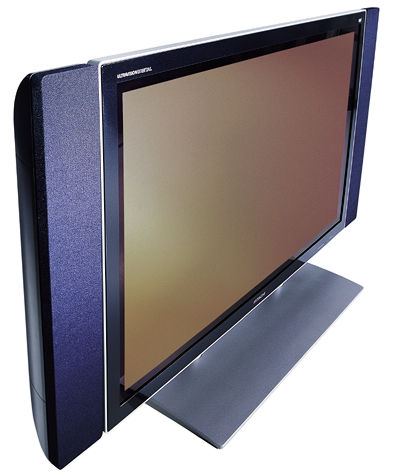Hitachi 42HDT20 16:9 plasma television

Industry watchers have been predicting that, as their prices drop and their performance improves, plasma displays will become an attractive alternative to CRTs. That's the goal of Fujitsu Hitachi Plasma Ltd. (FHP), the company responsible for the 16:9, 1024x1024-pixel display that's the heart of the two-piece Hitachi 42HDT20. As I reported in my July/August "Utopia Theater" column, in a joint venture, Fujitsu and Hitachi have built, on the Japanese island of Kyushu, a sprawling, almost self-contained factory dedicated to manufacturing 32- and 42-inch plasma displays. Their expressed intent is to attack the CRT market worldwide, especially in Europe and Asia, where living space is scarce.
While it's not exactly inexpensive at a list price of $8999 (drop $1000 for the street price), the 42HDT20 pushes all the right buttons. Its high-quality picture performance, attractive physical appearance, and convenient operating features should help speed the flat-panel transition—especially for videophiles. More than just the next plasma display, the 42HDT20 is a complete video system—one of a handful of such plasma products. It includes an external switcher-processor, the AVC20, which has two cable-ready NTSC tuners for picture-in-picture display, and four rear-panel A/V inputs: two S-video/composite and two component/RGB (selectable from the remote control in the onscreen menu).
One of the component/RGB inputs is 15-pin D-sub RGBHV analog—the kind RCA used on its now-discontinued DTC-100 DirecTV high-definition set-top box. The other is the new digital DVI connector with HDCP copy protection, which will be standard on all new DirecTV HD STBs. DVI passes the digital signal directly from the satellite receiver to the monitor. On a fixed-pixel display, such as a plasma, this bypasses a D/A and A/D conversion cycle. The result should be an even better picture than what's currently available, but you can't record a copy-protected DVI datastream.
Behind the front-panel door of the AVC20 is another set of S-video/composite inputs, as well as some controls that owners will use only if they lose the remote. Also included is a 10W stereo amplifier to drive a pair of tall, skinny, reasonably decent-sounding flush-mount speakers that few SGHT readers will use. A subwoofer-out jack is included if you're stuck using these speakers and want some low bass. Two rear-mounted IR-blaster outputs go with the two included IR blasters, with which the AVC20 can control four components using Hitachi's A/V Network and Setup Wizard. I didn't use that, but I did find it really easy to get the extremely well-organized, backlit remote to control my DTC-100 and a number of DVD players.
Hey, ALIS!
The 42HDT20's plasma panel uses FHP's Alternating Lighting of Surface (ALIS) technology to increase vertical resolution. I provided a short explanation of this technology in my July/August "Utopia Theater" column, avoiding a complete discussion by saying that a full description would "have to wait for a full review"—not knowing I'd be doing the review. Here's a simplified explanation of how ALIS can provide twice the vertical resolution of conventional plasma technology while using the same number of horizontal electrode strips. Don't be surprised if, after reading this, you look as glazed as some plasma displays.
A conventional plasma panel displays an image by illuminating all of its horizontal lines of pixels simultaneously at a rate of 60 (actually, 59.94) times per second. A single display line consists of two electrode strips (let's label them A and B) fixed horizontally across the panel, with alternating red, green, and blue phosphors for each pixel arrayed horizontally behind the pair of electrodes. Each phosphor is separated from its neighbors by a nonluminous barrier. Individual pixels are independently activated by applying a voltage across the pair of horizontal electrodes (called the display electrodes) and a pair of vertical electrodes called the address electrodes, which intersect at the desired pixel.
When voltage is applied to the display and address electrodes, the gas (plasma) emits ultraviolet rays, which cause the phosphors in the associated pixel to glow. A horizontal interval, or nonluminous space, between pairs of display electrodes is required to prevent interference between vertically adjacent phosphor cells. As a result, some of the screen real estate is never used to display any part of the picture.
ALIS technology spaces the horizontal electrodes evenly, with no nonluminous space between them. Instead, the phosphors run in unbroken vertical strips so that all areas between electrodes can be used for luminance.
Rather than displaying a frame with all pixels firing 60 times a second, ALIS drives alternating rows of pixels 60 times a second in a fashion similar to an interlaced CRT scan. Consider three adjacent horizontal lines in a conventional plasma display, which are driven by three pairs of horizontal electrodes (let's label them A/B, C/D, and E/F) with nonluminous spaces between each pair. In this case, the three lines fire simultaneously 60 times per second. With ALIS, the six electrodes have no nonluminous spaces between them, and they alternate their pairings: first, pairs A/B, C/D, and E/F fire, followed by pairs B/C and D/E, and so on, back and forth. This provides five lines in the space normally used for three. The voltage for the lines that are not supposed to fire is canceled out, so they remain dark during that period.
- Log in or register to post comments














































